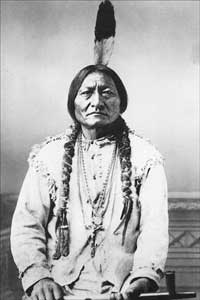Native Americans flee from the allegorical representation of Manifest Destiny, Columbia, painted in 1872 by John Gast (Photo credit: Wikipedia)
In the last post I tried to explain that the two civilizations that confronted each other when the United States cleared its wilderness had very different social and political structures because of the difference in how they viewed and used land. For the Indians, land was something held in common by everyone but owned by no one. For Whites, land was property with its value set by the market. We used the Common Law and the political system based on Common Law to secure and protect property; Indians had no law to protect property, hence, no political system based on anything like our conception of laws.
Added to this different view of land was how it was used. Indigenous populations used land for subsistence; they took what they needed from the land but what they took was the amount required for survival of the tribe. For white Americans, what was produced from the land very quickly passed from subsistence of people living on the land to commercial enterprise in faraway markets. Within one generation after the frontier was opened to settlement, even the settlers were deriving their primary goods from faraway markets, delivered to them by wagons, canals and trains.
This difference in how we used land only intensified the degree to which white settlers and the promoters of settlement (commercial interests, government) viewed the Indians as a less-civilized species whose removal from the frontier was a “natural” consequence of the change from wilderness to settled lands. And the “proof” that the Indians weren’t civilized was the extent to which all our efforts to provide them with the advantages of our civilization through the development of the reservation system ultimately failed.
What’s so interesting about the Indian-White confrontation in North America is that at the beginning, when fur trappers and traders first went West over the Great Plains and through the Rockies, they had a much different view of the Indian civilization than what later emerged when we later pushed the Indians out of the way. Not only did the early Western explorers need the Indians to show them the trails, the watering-holes and the game, they also reflected again and again on the civilized manner in which the Indians behaved. Here’s the description of a Snake chief recorded by a member of the Wyeth expedition that crossed the Rockies in 1834: “The chief is a man about fifty years of age, tall and dignified looking with large, strong aquiline features. His manners were cordial and agreeable.” And here’s a description of Indians met by another traveler in 1810: “Their manner of speaking is extremely dignified and energetic. They gesticulate with great force, freedom and animation.”
These early descriptions of the ‘uncivilized’ inhabitants of our ‘wilderness’ can be found in many of the journals and letters of Western explorers collected on a remarkable website devoted to the history of the Western fur trade. Reading these documents, and comparing their contents to the “Manifest Destiny” exhortations of Polk or John Quincy Adams makes clear just how different were the views of Whites and Indians about the land in which both were now having to live. Did the inability of indigenous peoples to cut canals, railroad tracks and highways through this landscape mark them as savages? You decide.
Based on my book, Hunters in the Wilderness. Volume II in the series, Guns in America, to be published in December.
Related articles
- John Smith- close minded settler or open minded adventurer? (samanne19.wordpress.com)



